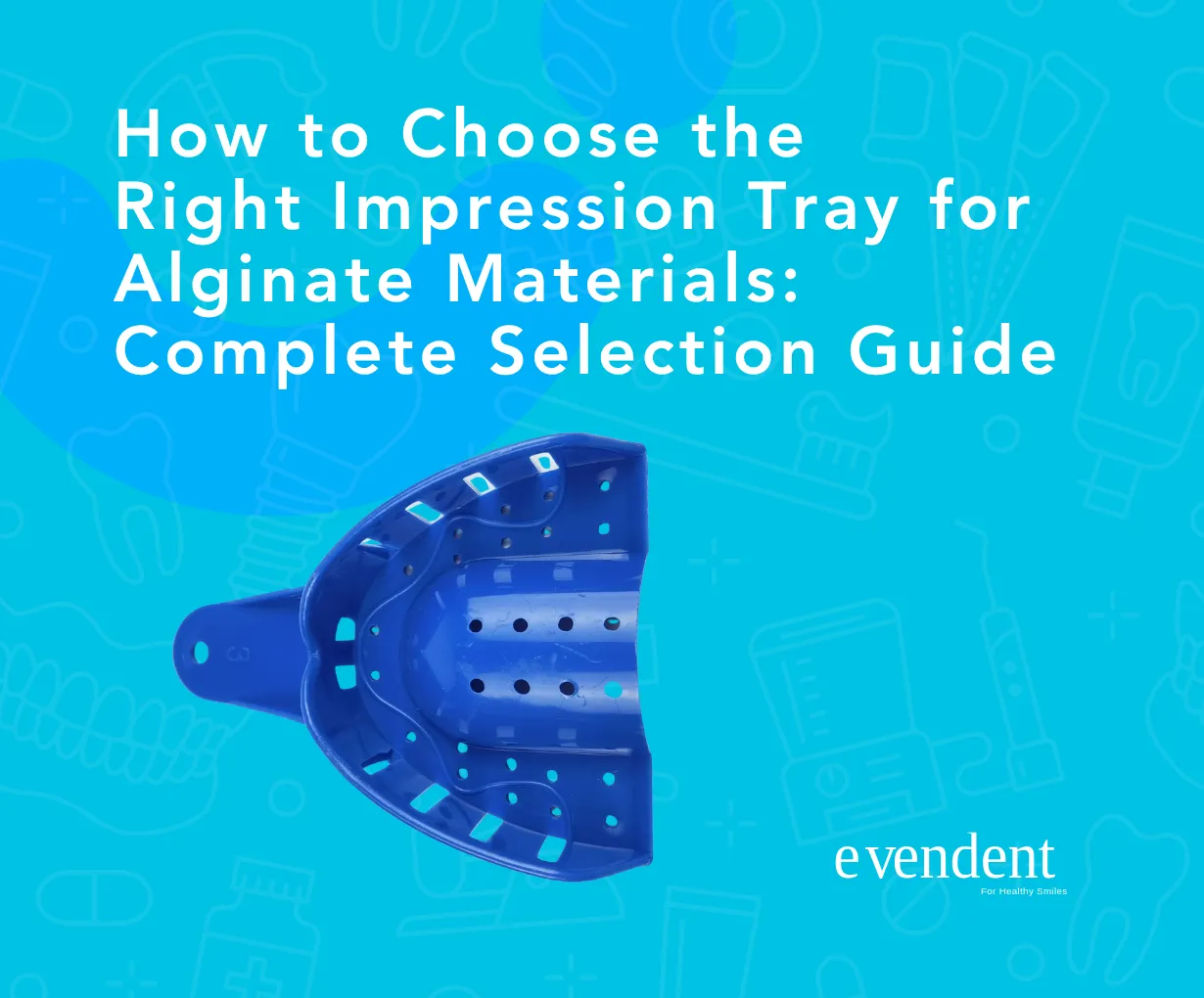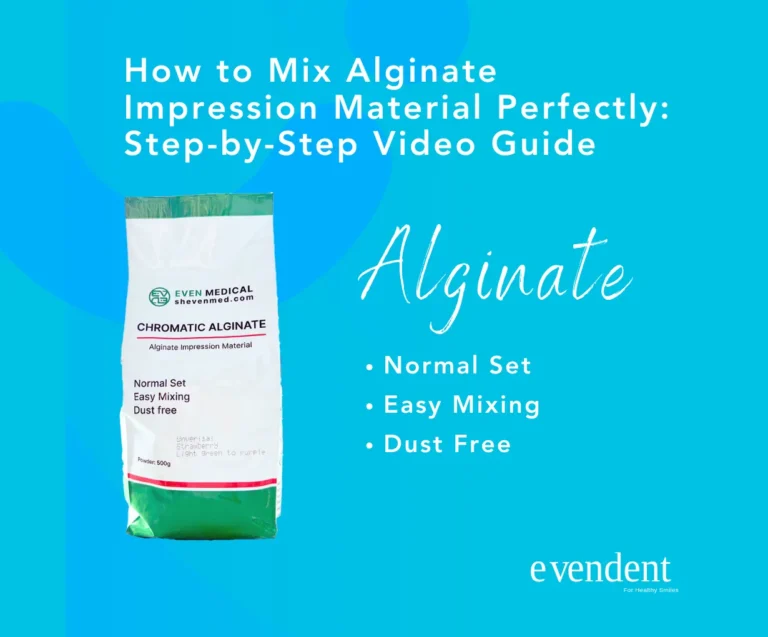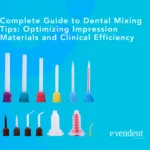Selecting the appropriate impression tray is crucial for achieving accurate alginate impressions and optimal clinical results. The right tray ensures proper material distribution, adequate thickness, and comfortable patient positioning while maximizing the performance of your alginate impression materials. Understanding tray types, sizing principles, and material compatibility will significantly improve your impression quality and reduce remake rates.
Understanding Impression Tray Fundamentals
What Makes a Quality Impression Tray?
A quality impression tray serves as the foundation for successful alginate impressions, providing structural support and ensuring uniform material thickness. The tray must maintain dimensional stability under the pressure of setting alginate while allowing easy removal without distortion.
Key Functions:
- Material retention : Secure alginate during setting and removal
- Structural support : Prevent deformation under masticatory forces
- Uniform thickness : Ensure consistent 3-4mm alginate thickness
- Patient comfort : Minimize tissue trauma and discomfort
- Clinical efficiency : Streamline impression procedures

Essential Tray Components
Handle Design
- Ergonomic grip for secure control
- Positioned for optimal insertion angle
- Adequate length for comfortable manipulation
Rim Configuration
- Rounded edges to prevent soft tissue trauma
- Appropriate height for material retention
- Smooth surfaces for patient comfort
Perforation Pattern
- Strategic holes for mechanical retention
- Optimal size to prevent alginate extrusion
- Uniform distribution for consistent adhesion
Types of Impression Trays for Alginate Use
1. Metal Impression Trays
Advantages:
- Superior dimensional stability
- Autoclavable for repeated use
- Excellent alginate retention
- Cost-effective for high-volume practices
- Compatible with all alginate types
Disadvantages:
- Heavier weight during impression
- Potential for patient discomfort
- Higher initial investment
- Requires sterilization between uses
Best Applications:
- Routine diagnostic impressions
- Study model fabrication
- High-volume general practices
- Long-term cost considerations
2. Plastic Dental Impression Trays
Advantages:
- Lightweight and comfortable
- Disposable options available
- Transparent varieties for visibility
- Chemical resistance
- Lower per-use cost
Disadvantages:
- Limited dimensional stability
- Single-use environmental impact
- Potential for flexion under pressure
- Variable quality between manufacturers
Best Applications:
- Infection control protocols
- Pediatric dentistry
- Temporary or emergency procedures
- Practices prioritizing disposability

3. Plastic-Steel Dental Impression Tray
Advantages:
- Excellent mechanical retention
- Prevents alginate slippage
- Optimal material thickness control
- Professional appearance
- Suitable for complex cases
Disadvantages:
- Higher cost per unit
- Requires proper loading technique
- May need adhesive backup
- Limited size variations
Best Applications:
- Precision prosthetic work
- Complex jaw relationships
- Quality-focused practices
- Challenging anatomical cases

4. Perforated vs. Non-Perforated Trays
Perforated Trays:
- ✅ Superior mechanical retention
- ✅ Reduced alginate slippage
- ✅ Better material adhesion
- ✅ Suitable for all alginate types
- ❌ More difficult to clean (reusable types)
Non-Perforated Trays:
- ✅ Easier cleaning and sterilization
- ✅ Smoother tissue contact
- ✅ Better for adhesive systems
- ❌ Requires tray adhesive
- ❌ Higher risk of material separation
Tray Sizing and Selection Criteria
Anatomical Considerations
Maxillary Tray Selection:
- Arch width : 2-3mm wider than widest point
- Arch length : Extends 2-3mm beyond last tooth
- Palatal coverage : Complete palatal surface
- Tissue clearance : 3-4mm for adequate alginate thickness
Mandibular Tray Selection:
- Arch width : Accommodates widest buccal surfaces
- Arch length : Extends beyond retromolar pads
- Lingual clearance : Adequate space for tongue comfort
- Floor coverage : Complete vestibular extension
Standard Sizing Guidelines
Small Trays:
- Maxillary : 45-50mm arch width
- Mandibular : 40-45mm arch width
- Applications : Pediatric patients, narrow arches
- Age range : Children 6-12 years typically
Medium Trays:
- Maxillary : 50-55mm arch width
- Mandibular : 45-50mm arch width
- Applications : Average adult patients
- Most common : 70-80% of adult population
Large Trays:
- Maxillary : 55-60mm arch width
- Mandibular : 50-55mm arch width
- Applications : Broad arches, large patients
- Considerations : Ensure patient comfort
Special Sizing Considerations
Edentulous Patients:
- Require different tray proportions
- Focus on denture-bearing areas
- Consider ridge resorption patterns
- May need custom tray fabrication
Pediatric Patients:
- Smaller tray dimensions
- Comfortable handle positioning
- Rounded edges essential
- Consider behavioral factors
Orthodontic Cases:
- Accommodate bracket clearance
- Consider arch expansion
- Plan for appliance interference
- May require modified trays
Material Compatibility with Alginate Types
EvenDent Alginate Compatibility
Universal Type Alginate (E50001):
- Ideal trays : Perforated metal or plastic
- Thickness requirement : 3-4mm uniform
- Retention : Mechanical (perforations) or adhesive
- Setting time : 3-minute accommodation needed
High Precision Type Alginate (E50002):
- Ideal trays : Metal with fine perforations
- Precision requirements : Dimensional stability crucial
- Thickness control : Consistent 3-4mm critical
- Applications : Crown and bridge impressions
Super High Precision Type Alginate (E50003):
- Ideal trays : High-quality metal rim-lock
- Precision demands : Maximum dimensional accuracy
- Quality considerations : Professional-grade trays only
- Applications : Complex prosthetic cases
Tray Adhesive Considerations
When to Use Adhesive:
- Non-perforated trays
- Smooth plastic surfaces
- Critical accuracy requirements
- Difficult anatomical cases
Application Technique:
- Thin, uniform coating
- Allow proper drying time
- Avoid pooling in tray
- Compatible with alginate chemistry
Step-by-Step Tray Selection Process
1. Patient Assessment
Measure Arch Dimensions:
- Use flexible measuring tape
- Record widest buccal width
- Measure anterior-posterior length
- Note any anatomical variations
Evaluate Oral Anatomy:
- Assess vestibular depth
- Check for tori or exostoses
- Identify limited opening
- Consider gag reflex sensitivity
2. Tray Trial and Verification
Fit Assessment:
- Anterior clearance : 2-3mm beyond incisors
- Posterior extension : Past last molars
- Lateral clearance : 2-3mm beyond buccal surfaces
- Tissue clearance : 3-4mm for alginate thickness
Comfort Evaluation:
- No tissue blanching
- Comfortable insertion and removal
- Adequate breathing space
- No pressure points
3. Final Selection Criteria
Priority Factors:
- Patient comfort : Primary consideration
- Alginate thickness : Uniform 3-4mm
- Retention adequacy : Mechanical or adhesive
- Clinical efficiency : Streamlined workflow
- Cost-effectiveness : Practice economics
Tray Preparation and Loading Techniques
Pre-Impression Preparation
Tray Inspection:
- Check for cracks or damage
- Verify proper size selection
- Ensure clean, dry surfaces
- Apply adhesive if required
Patient Positioning:
- Upright, comfortable position
- Head support adequate
- Breathing instructions clear
- Evacuation system ready
Optimal Loading Technique
Alginate Distribution:
- Posterior loading : Fill posterior regions first
- Anterior placement : Smooth anterior coverage
- Excess material : Slight overflow acceptable
- Air bubble prevention : Gentle placement technique
Loading Sequence:
- Mix alginate : Following manufacturer’s ratio (10g:22mL for EvenDent)
- Load posterior : Fill deepest areas first
- Smooth anterior : Even distribution
- Check thickness : Ensure adequate material
- Immediate insertion : Within working time
Insertion and Positioning
Insertion Technique:
- Approach angle : Slightly posterior first
- Gentle pressure : Avoid tissue trauma
- Centering : Ensure midline alignment
- Seating : Complete, even pressure
Holding Position:
- Stable grip : Secure tray handle
- Patient guidance : Breathing instructions
- Timing : Monitor chromatic color change
- Removal preparation : Steady, controlled motion
Troubleshooting Common Tray Issues
Problem: Alginate Separation from Tray
Causes:
- Inadequate mechanical retention
- Missing or insufficient adhesive
- Tray surface contamination
- Premature tray removal
Solutions:
- Use perforated trays for mechanical retention
- Apply proper tray adhesive technique
- Ensure clean, dry tray surfaces
- Wait for complete alginate setting (3 minutes)
Problem: Inadequate Alginate Thickness
Causes:
- Oversized tray selection
- Insufficient material loading
- Improper tray positioning
- Patient movement during setting
Solutions:
- Select properly sized tray (3-4mm clearance)
- Load adequate alginate volume
- Ensure proper tray seating
- Provide clear patient instructions
Problem: Distorted Impressions
Causes:
- Tray flexion during setting
- Inadequate dimensional stability
- Improper removal technique
- Patient movement
Solutions:
- Use rigid, high-quality trays
- Ensure proper tray selection
- Train proper removal technique
- Improve patient communication
Problem: Patient Discomfort
Causes:
- Oversized tray selection
- Sharp or rough tray edges
- Excessive insertion pressure
- Inadequate patient preparation
Solutions:
- Select appropriate tray size
- Inspect tray edges for smoothness
- Use gentle insertion technique
- Provide thorough patient education
Cost-Effectiveness Analysis
Disposable vs. Reusable Trays
Disposable Plastic Trays:
- Cost per use : $0.50-1.50
- Advantages : No sterilization, infection control
- Disadvantages : Environmental impact, ongoing cost
- Best for : High-volume practices, infection control priorities
Reusable Metal Trays:
- Initial investment : $15-30 per tray
- Cost per use : $0.05-0.15 (including sterilization)
- Advantages : Long-term economy, superior quality
- Disadvantages : Sterilization time, initial cost
- Best for : Quality-focused practices, long-term economics
Total Cost of Ownership
Factors to Consider:
- Tray purchase cost : Initial investment
- Sterilization costs : Time and materials
- Replacement frequency : Durability factors
- Remake rates : Quality impact on clinical outcomes
- Staff time : Efficiency considerations
ROI Optimization
High-Volume Practices:
- Consider reusable metal trays
- Invest in quality for durability
- Calculate break-even point
- Factor in remake reduction
Quality-Focused Practices:
- Prioritize dimensional stability
- Consider rim-lock designs
- Invest in precision tools
- Monitor accuracy outcomes
Selection Recommendations by Practice Type
General Dental Practice
Recommended Setup:
- Metal perforated trays : 3 sizes each arch
- Plastic disposable backup : For infection control
- Tray adhesive : For non-perforated applications
- Sterilization system : Efficient turnover
Rationale:
- Cost-effective long-term solution
- Excellent alginate retention
- Suitable for routine impressions
- Balanced quality and economics
Prosthodontic Practice
Recommended Setup:
- High-quality metal rim-lock trays : Multiple sizes
- Precision perforated trays : For accuracy
- Custom tray materials : For complex cases
- Quality adhesive systems : Professional grade
Rationale:
- Maximum dimensional accuracy
- Superior alginate retention
- Professional appearance
- Precision requirements
Orthodontic Practice
Recommended Setup:
- Perforated metal trays : Bracket clearance
- Pediatric sizes : Complete range
- Comfortable handles : Patient-friendly design
- Efficient workflow : High-volume considerations
Rationale:
- Accommodate orthodontic appliances
- Pediatric patient comfort
- High-volume efficiency
- Study model accuracy
Pediatric Dental Practice
Recommended Setup:
- Small perforated trays : Complete size range
- Comfortable designs : Rounded edges
- Bright colors : Patient engagement
- Disposable options : Infection control
Rationale:
- Child-specific sizing
- Comfort and safety priorities
- Behavioral considerations
- Infection control needs
Quality Assurance and Maintenance
Tray Inspection Protocol
Daily Checks:
- Visual inspection for cracks
- Handle stability verification
- Perforation integrity
- Edge smoothness assessment
Weekly Maintenance:
- Deep cleaning procedures
- Sterilization effectiveness
- Dimension verification
- Replacement planning
Sterilization Best Practices
Autoclave Protocols:
- Temperature : 121°C (250°F)
- Time : 15-20 minutes
- Pressure : 15 psi
- Drying : Complete cycle
Chemical Sterilization:
- Glutaraldehyde : 2-4% solution
- Immersion time : 10-12 hours
- Rinsing : Thorough with sterile water
- Drying : Sterile environment
Replacement Indicators
When to Replace:
- Visible cracks or damage
- Perforation enlargement
- Handle loosening
- Dimensional changes
- Excessive wear patterns
Integration with Digital Workflows
Hybrid Approaches
Digital-Physical Integration:
- Physical impressions for accuracy
- Digital scanning for verification
- Model fabrication optimization
- Workflow efficiency
Benefits:
- Quality assurance
- Reduced remakes
- Enhanced accuracy
- Future-ready protocols
Transition Considerations
Gradual Implementation:
- Maintain alginate capabilities
- Selective digital adoption
- Staff training priorities
- Economic considerations
Future Trends in Impression Tray Technology
Material Innovations
Advanced Plastics:
- Improved dimensional stability
- Enhanced biocompatibility
- Reduced environmental impact
- Cost-effective manufacturing
Smart Materials:
- Temperature-responsive components
- Integrated timing indicators
- Comfort-optimized designs
- Patient-specific adaptations
Design Evolution
Ergonomic Improvements:
- Enhanced patient comfort
- Improved practitioner control
- Reduced fatigue factors
- Universal sizing approaches
Sustainability Focus:
- Biodegradable materials
- Reusable designs
- Reduced packaging waste
- Environmental responsibility
Conclusion and Best Practices
Selecting the right impression tray is fundamental to achieving consistent, high-quality alginate impressions. The ideal tray provides adequate material space, secure retention, and patient comfort while supporting the specific characteristics of your chosen alginate material.
Key Selection Principles:
- Size appropriately : 3-4mm clearance for optimal alginate thickness
- Prioritize retention : Perforated trays or quality adhesive systems
- Consider practice type : Match tray selection to clinical needs
- Invest in quality : Superior trays improve outcomes and reduce costs
- Maintain properly : Regular inspection and sterilization protocols
Success Factors:
- Proper patient assessment and measurement
- Appropriate tray trial and verification
- Correct alginate loading techniques
- Gentle insertion and positioning
- Complete setting time adherence
Economic Considerations:
- Balance initial cost with long-term value
- Calculate true cost per use including sterilization
- Factor in remake rates and quality outcomes
- Consider practice volume and workflow efficiency
By following these guidelines and selecting appropriate impression trays, dental professionals can maximize the performance of their alginate impression materials while ensuring patient comfort and clinical efficiency.
Optimize Your Impression Results with Quality Trays
Ready to improve your alginate impression accuracy and efficiency? The right impression tray is essential for maximizing the performance of your alginate materials and achieving consistent clinical results.
Why Professional Tray Selection Matters
✅ Improved Accuracy – Proper tray selection ensures optimal alginate thickness and dimensional stability
✅ Enhanced Retention – Quality trays prevent alginate separation and impression distortion
✅ Patient Comfort – Appropriate sizing and design reduce discomfort and improve cooperation
✅ Clinical Efficiency – Streamlined workflows and reduced remake rates
✅ Cost-Effectiveness – Lower long-term costs through quality outcomes and durability
Tray Recommendations for EvenDent Alginate Materials
For Universal Type Alginate (E50001):
- Metal perforated trays for routine impressions
- Standard sizing with 3-4mm clearance
- Cost-effective solutions for general practice
For High Precision Type Alginate (E50002):
- Quality metal trays with fine perforations
- Dimensional stability for crown and bridge work
- Professional-grade retention systems
For Super High Precision Type Alginate (E50003):
- Premium rim-lock or high-quality metal trays
- Maximum dimensional accuracy for complex cases
- Investment-grade tools for specialist practices
Complete Impression Solution
Combine EvenDent chromatic alginate materials with quality impression trays for optimal results:
- 20μm particle fineness for exceptional detail
- Color-change indicators for perfect timing
- Three precision levels for every application
- Dust-free formula for cleaner procedures
Get Expert Guidance
🌐 Visit our website : evendent.com
📧 Technical consultation : Product selection and clinical guidance available
📦 Sample requests : Try our alginate materials with your preferred trays
Shanghai Even Medical Instruments Co., Ltd
Expert Support : Comprehensive clinical training and product education
Quality Assurance : ISO certified manufacturing with rigorous testing
Global Service : International shipping and technical support
Professional Partnership : Dedicated to your clinical success
Maximize your alginate impression results with the right combination of quality materials and professional trays. Contact EvenDent today for personalized product recommendations and clinical guidance.
Continue Reading:





